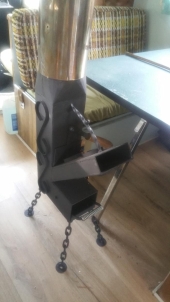Glenn Herbert wrote:Where does combustion air enter, just through the pellet hopper, or the ash door too? I see a wooden handle; what does that control and how?
The air enters through the bottom through the ash door, a bit of air also enters the hopper when the pelletts get low. The effect seems more pronounced when I run the stove inside. I was going to make a cap for the hopper but read that wood gas might fill up the hopper.
The wooden handle controls the amount of pellets coming in to the burn chamber. So, pulling the handle down will raise the gate in the hopper allowing more fuel in. The lower yellow handle controls how much air comes in. I usually run the intake full open, unless the fire burns too hot.
The only idea I had was inserting a metal sleeve in the hopper to get more air into the burn chamber. When I had the paper covering the hopper, I moved it so there was a half inch gap and the stove roared back to life. The other idea was to cut the bottom of the stove off and add another inch of metal. I don't want to go through all that chopping and welding if it won't work though.








